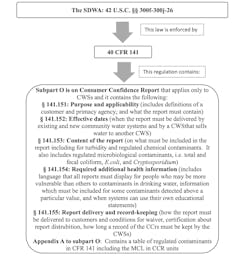What are Consumer Confidence Reports (CCRs)?
Saleha Kuzniewski, Ph.D. has written on several scientific and legal issues and is an environmental scientist specializing in remediation and biotechnology research. Dr. Kuzniewski received her Ph.D. in Environmental Science and Public Policy from George Mason University. Kuzniewski can be reached at [email protected]
What is a CCR?
A consumer confidence report (CCR), also known as an annual drinking water quality report or simply as a water quality report, provides information to customers from their water utility about their community water system’s drinking water quality. The US EPA requires community water systems to deliver CCRs to their customers. There is specific information and a format that must be followed for all CCRs and this will be discussed further in this article.
Community water systems (CWSs) are a part of the public water systems, accounting for one-third of the public water systems (PWSs) and as of 2019, serving 94.1% of the population. So is a PWS report the same as a CCR? Not necessarily. A PWS report could be any water report – a CCR for the CWS or a report on the other water systems in the PWS. These are transient and non-transient non-community water systems, serving 4% and 2% of the population respectively, and surface water. Private wells, while a source of drinking water for 15% of the population, are not included in PWSs.
Who regulates CCRs?
The CCRS are regulated in 40 CFR (Code of Federal Regulations) that fall under the Safe Drinking Water Act (SDWA) and this regulatory structure is summarized in Figure 1.
Figure 1: Regulatory structure for the CCRs and content of Subpart O
What role does the US EPA play in CCRs?
Congress authorized the US EPA to set regulations for the SDWA and these regulations, known as 40 CFR 141 (The National Primary Drinking Water Regulations) include regulations on CCRs for CWSs (Figure 1). The US EPA manages and enforces 40 CFR 141 and this means, the EPA manages and enforces the regulations for the CCRs.
Additionally, the US EPA plays the following specific roles in 40 CFR 141 Subpart O (i.e. in the regulations for the CFRs). For specific details, click on the links:
- In § 141.151 (Purpose and applicability of subpart O) (f): The appropriate US EPA regional office may carry out primary enforcement responsibility for public water systems in certain situations.
- In § 141.153 (Content of the reports):
- In § 141.154 (Required additional health information):
- In § 141.155 (Report delivery and record-keeping):
- (b) This clause includes that the EPA expects that adequate good faith effort will be planned to deliver CCRs to consumers who are served by the CWSs but are not bill-paying customers.
What roles does the CDC play in CCRs?
In addition to providing guidelines to reduce the risk of infection by Cryptosporidium in § 141.154 (a), as described above in this article, the CDC also:
- provides basic information about the CCRs as in 40 CFR 141 Subpart O
- maintains the National Outbreak Reporting System (NORS)
- perform research on health impact and develop new analytical methods for detecting contaminants including some in the NPDWRs and mentioned in the regulations for the CCRs.
These points imply that the CDC supports the EPA in performing its duties and responsibilities in enforcing the regulations for CCRs.
When are CCRs from CWSs for water quality due?
By July 1st of each year. However, the dates could vary depending on existing/new CWSs and if it sells water to another CWS and this is summarized in Table 1 based on § 141.52.
Table 1: The annual due dates to customersa for CCRs from CWSs for water quality
|
CWS |
Due date for CCR to customersa |
CCR issued to whom? |
Where is this specified in 40 CFR 141 § 141.152? |
|
Existing CWS |
1st report due by October 19, 1999, 2nd by July 1, 2000 and after this, July 1st annually |
Customers |
(b) |
|
New CWS |
July 1st of the year after one full calendar year in operation and annually after this |
Customers |
(c) |
|
CWS that sells water to another CWS |
By April 19, 1999, April 1, 2000 and every April after this OR on a date mutually agreed upon by the seller and buyer and specifically included in a contract between the two |
Must deliver the applicable information in § 141.153 to the buyer system |
(d) (1) and (2) |
a: Definition of customer in 40 CFR 141 § 141.151 (b): billing units or service connections to which water is delivered by a community water system.
How can I get a CCR for my water?
Every CWSs are required to mail or directly deliver a copy of the CCR to each customer, § 141.155 (a), unless they fit into the waiving criteria in § 141.155 (g). CCRs must be available to the public on request, § 141.155 (e) and copies must be retained by the CWSs for a minimum of three years, § 141.155 (2) (h). Copies of the CCRs for CWSs typically serving more than 100,000 people are also available on the internet on these websites:
- The EPA’s CCR search tool
- On the websites for some of the state’s Department of Health, Department of Environmental Protection, or Commission on Environmental Quality. e.g. On the websites for Minnesota Department of Health, the Pennsylvania Department of Environmental Protection, and the Texas Commission on Environmental Quality.
- For private ground water wells: there are no requirement to issue a CCR as they are not regulated by the EPA.
What is included in a CCR for my water?
All CCRs by CWSs must include specific information as in 40 CFR 141 Subpart O § 141.153 and § 141.154. The CDC also includes a generalized outline of what is included in a CCR.
The following are weblinks to some of the available CCRs to illustrate the specific information they contain and their format:
- 2021 Consumer Confidence Report for Douglasville-Douglas County (Douglasville, GA) https://www.ddcwsa.com/wp-content/uploads/2021/07/WSA-CCR-2021-FINAL-spread-combo-v3.pdf
- 2020 Water Quality Report for Hixson Utility District (Hixson, TN) https://www.hixsonutility.com/news/2021-consumer-confidence-report/
As could be seen from the above examples, these CCRs for CWSs include the following basic information:
- The calendar year the report covers
- The source of the drinking water
- Terms, abbreviations, and definitions of the terms
- A table containing:
- detected values for the regulated contaminants and the MCLs
- Date of sampling
- Whether the contaminant detected and quantified is in violation
- The likely source of origin of the contaminant in the water
Overall, they contain information and the specific language as required in 40 CFR 141 Subpart O § 141.153 and § 141.154
About the Author
Saleha Kuzniewski
Saleha Kuzniewski, Ph.D. has authored several publications in the fields of scientific research, biotechnology, and environmental regulations. She is the winner of the 2023 Apex award for publication excellence. She is also the founder of Environmental Remediation & Innovations, LLC. Kuzniewski can be reached at [email protected].



